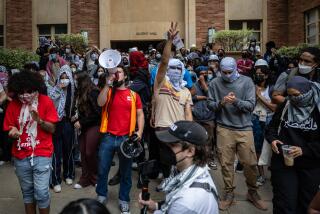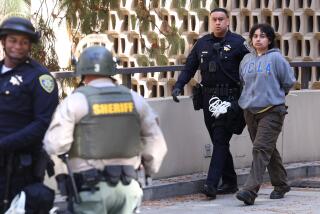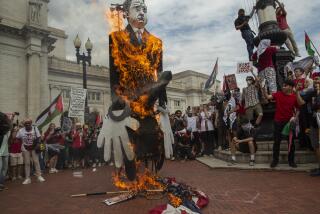‘Battle of Seattle’ Crusaders Head to D.C.
WASHINGTON — Springtime invaders of the nation’s capital usually come armed with little more than cameras, sunglasses and a desire to see the cherry blossoms and the city’s other tourist attractions.
But when Lisa Fithian of Los Angeles prepared for her trip, she packed goggles and a handkerchief--to ward off tear gas--memories of wild civil unrest in Seattle and a desire to transform what she sees as an unjust global economy.
“People aren’t here because they want to be arrested,” said Fithian, a veteran community activist and Echo Park resident. “They’re here because they want to say: ‘No more business as usual.’ ”
It was last December that an unlikely army of protesters disrupted a meeting of the World Trade Organization, turning downtown Seattle into a war zone and sparking mass arrests. The same crusade is now targeting Washington for a series of demonstrations beginning next week and expected to reach a crescendo around April 16.
The immediate goal is to follow up on Seattle by shutting down the spring meetings of the World Bank and International Monetary Fund, global financial organizations despised by critics as the WTO’s partners in an “evil triad” atop the world economy.
Web Promotes Demonstrations
“Seattle, Round Two?” asks one of at least 74 Web sites that are promoting the imminent demonstrations.
Government officials and law enforcement agencies, from local police to the Secret Service, are taking that question seriously. Braced for thousands of activists, the Washington force has speeded up civil disturbance training for 1,500 officers, canceled days off, studied video footage from Seattle and arranged for emergency backup officers from suburban forces.
Most of the protest leaders have renounced the violence and vandalism that left windows smashed in downtown Seattle. But their pronouncements on nonviolent civil disobedience, such as attempting to block IMF headquarters, are less clear, a sign that has caught the attention of security officials.
An activist group from Minneapolis, for example, plans training sessions on such skills as “understanding police street tactics and weapon use so as to lessen their effectiveness and First Aid/personal protection to help our injured comrades,” according to an Internet posting.
‘Gentle or . . . Forceful’
“We will be as gentle or as forceful as we need to be--depending on what they do,” Police Chief Charles H. Ramsey said in an interview. He called the protesters “very organized. This is not like the ‘60s and ‘70s.”
If the use of cell phones and the Internet separates today’s protesters from their 1960s peers, so does the broad sweep of their concerns.
The strange coalition of anti-global activists will come to Washington with grievances including Starbucks’ treatment of coffee farmers in Latin America, China’s use of dog and cat fur in apparel manufacturing and America’s addition of growth hormones to its cattle feed. It has made for an almost surreal backdrop to a dry series of financial meetings that usually draw no interest from the public.
When a German news reporter jokingly asked the IMF’s acting boss, Stanley Fischer, if he had considered using helicopters as a way to ferry delegates over lines of rioting protesters, Fischer responded: “We hadn’t figured that one out--maybe it’s not a bad idea.”
The causes that animate the anti-global crowd may seem exotic to many members of the public. But they are hitting a nerve on college campuses and in other circles. The “Battle of Seattle,” replete with tales of pepper spray, crowd-control grenades, rubber bullets and mass jailings, has taken on a legendary aura for a new generation of activists.
Indeed, when a Bay Area think tank reserved a Washington church for a “teach-in” on the evils of the global economy, the 1,200 seats were quickly snapped up. “We sold out a week ago and we’re still getting 150 calls a day from people who want to go to that event,” said Debi Barker, deputy director of the International Forum on Globalization in Sausalito. “Seattle was not a fluke. . . . The momentum is continuing in Washington.”
Just how the IMF and World Bank fit into this picture is a matter of some dispute. Sister institutions, they were created at the end of World War II, with the bank focused on development of emerging nations and the fund charged with the world’s financial stability.
Each has drawn fire for policies said to benefit local and Western elites at the expense of the poor.
Recently, the World Bank has been criticized for a pipeline that critics claim threatens the Cameroon rain forest, and the IMF has been assailed for demanding that borrower nations adopt austere budget policies to shore up their balance books.
“Defund the fund! Break the bank! Dump the debt!” proclaims the a16 Web site--its title a reference to April 16--which has become a clearinghouse for organizers (https://www.a16.org).
Officials of both institutions say that the protesters should sympathize with an IMF effort to ease poor-country debts and a World Bank initiative on AIDS. Such arcane matters of world finance, however, are being overshadowed by memories of Seattle demonstrators who formed human chains to block delegates from the WTO’s convention center.
“The local authorities, the local police forces are taking very seriously, as they must, the possibility of disruptions here,” the IMF’s Fischer recently told reporters. He declined to disclose the contingency plans.
Gathering on the Ellipse
The main, legal protest is set for April 16, when demonstrators gather on the Ellipse between the White House and the Washington Monument. As in Seattle, where small bands of protesters engaged in vandalism and defied police orders, no one is sure what to expect next.
“The protest [organizers] did not have control of their own members, if what they’re saying is true,” said Ramsey, the police chief. “I would hope they feel as much responsibility to control their own demonstrators as we do, because that kind of behavior was uncalled for.”
All that is certain is that they are coming, and bringing an evolving culture of social protest. Next week, small “affinity groups” of activists will link up with each other in an inner-city warehouse and begin to form a “spokescouncil” that will hash out tactics for the key days of April 16 and 17.
In the meantime, “there will be massive puppet-building going on every day. There will be workshops, trainings, issue forums,” said Madeline Gardner, who was answering phones one recent afternoon at the Mobilization for Global Justice.
‘Not Planning on Getting Arrested’
Gardner, 18, did not participate in the protests in Seattle but heard about them from friends and the media. “I was thrilled,” she said. “I was very, very excited that every day people, so many different people, came together out there.”
A Minneapolis native between high school and college, Gardner has little idea what is in store if the protests turn confrontational. “I’m not planning on getting arrested,” she said.
“I don’t rule out the possibility that a lot of people who just happen to be there will be arrested, because that’s what happened in Seattle,” she added.
Fithian, of Los Angeles, is looking ahead as well--to the Democratic National Convention, scheduled for mid-August in her hometown.
A former labor organizer who will turn 39 on the protest day of April 16, she sees Washington as just another in a long series of stops on the road to social justice.
“This movement is coming to Los Angeles,” she declared. “We want to look at each stop along the way and learn from it.”
More to Read
Sign up for Essential California
The most important California stories and recommendations in your inbox every morning.
You may occasionally receive promotional content from the Los Angeles Times.









